Special to Transport Topics
Contactless Delivery, Safety Precautions Accelerate Adoption of Electronic Bills of Lading
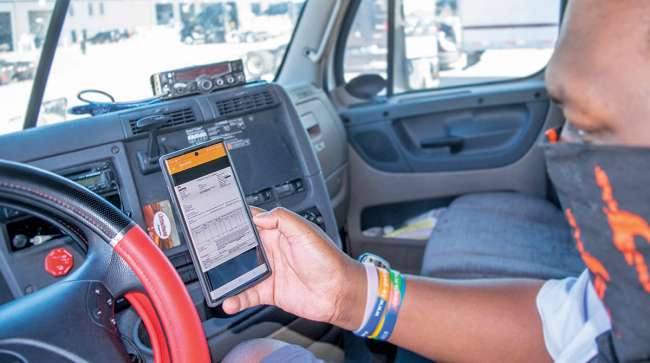
[Ensure you have all the info you need in these unprecedented times. Subscribe now.]
Fleets and shippers have been taking extra precautions to help protect the professional truck drivers who have been serving on the front lines of the nation’s response to the coronavirus pandemic.
Apart from implementing general sanitation and social distancing measures to contain the spread of COVID-19, many trucking companies and their customers have moved forward with technologies such as electronic bills of lading that minimize drivers’ in-person contact.
The push to reduce paperwork is not new — some companies have been using electronic documents to streamline driver workflows and improve efficiency for years — but the focus on safety during the pandemic has renewed interest in digitizing documents.
Although drivers may be isolated while on the road, once they reach their destinations there are many opportunities for human interaction, which gives rise to potential COVID-19 safety concerns.
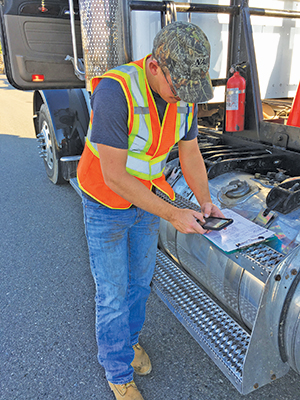
A driver uses Vector’s document-scanning app to electronically capture proof of delivery. Fleets and shippers have been taking steps to reduce physical interaction during the pandemic. (Vector)
The current emphasis on social distancing has created momentum for greater exploration of contactless delivery capabilities.
Since the pandemic took hold, there has been a clarion call to accelerate paperless transactions and make electronic bills of lading and other documents an industry standard.
In June, the Consumer Brands Association established the Contactless Delivery Task Force.
Tom Madrecki, CBA’s vice president of supply chain and logistics, said many business continue to rely heavily on paperwork and the old-school way of doing things.
“Because of COVID, and the health and safety component, it shined a light on an issue that was ripe for further discussion and refinement,” Madrecki said. “All of a sudden, it became really paramount that everyone in the supply chain stayed safe.”
That led to a task force of more than 35 members across the consumer packaged goods landscape, from retailers to carriers to technology facilitators.
Madrecki said the task force is examining increased standardization of contactless delivery, including delivery processes and data sharing, as well as integrating the technology into carriers’ and shippers’ existing platforms in the most efficient way possible.
The safety of the workforce within the supply chain is a top priority, said task force member Nick Shroeger, who is chief network solutions officer with Coyote, a third-party-logistics provider that is a wholly owned subsidiary of UPS Inc.
“If you think about where there’s the most interaction between different companies between carrier and shipper, it is when the driver is checking in and checking out, so how do we reduce the amount of manual touch points and contact points between two individuals?” he asked. “When you’re intersecting with so many independent drivers that check in and out of the facility, it’s hard to have that standardized process or practice to ensure safety for your people.”
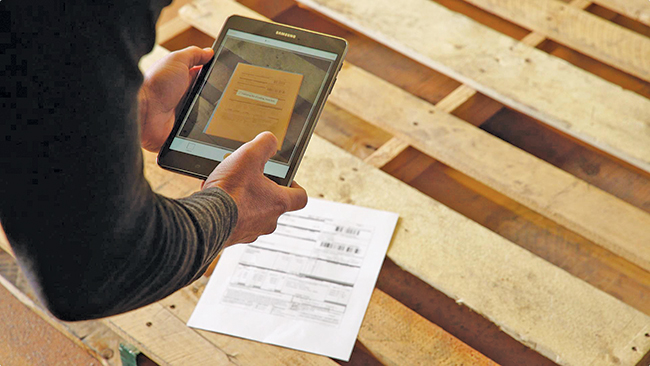
A worker uses a tablet to scan a paper document with Vector’s mobile application. (Vector)
This, he said, gave rise to an opportunity to create a scalable solution that eventually will become an industry standard.
Madrecki added that any software application needs to be flexible and nimble enough to work across a diverse industry in which different companies do things quite differently.
“Carriers don’t want 15 apps when they pull into a facility. Everybody wants a solution, just one that accounts for those different use cases and needs,” he said.
Many drivers are reluctant to download yet another app, a phenomenon Shroeger and Madrecki labeled “app fatigue.”
Electronic Documents Gain Momentum
Bills of lading are important legal documents because they essentially serve as a contract between consignor and consignee, they serve as receipt of freight, and they serve as the official transfer of ownership of goods.
Even before the pandemic, there was a slow though persistent movement to go paperless, a movement that is gaining steam in the face of COVID-19.
Though the technology may have been rooted in its original goal of efficiency, it is on its way to becoming an industrywide standard because of coronavirus safety concerns.
“It takes a lot of human interaction to pick up and deliver a load. What COVID has done is have people thinking outside the box,” Stevens Transport Vice President Robert Solimani said. “It has spurred the industry into advancing current technology into the 21st century to allow carriers, shippers and receivers to be on the same page as to how to make us more efficient.”
The Dallas-based trucking company ranks No. 49 on the Transport Topics Top 100 list of the largest for-hire carriers in North America.
For the past decade, adoption of electronic bills of lading was driven by efficiency, but now it’s a top initiative for supply chain leaders, said Brian Belcher, chief operating officer with Vector. The company makes a delivery workflow solution that shippers can deploy at their warehouses to eliminate delivery touch points.
“The No. 1 priority is obviously safety,” Belcher said. “A driver can unload and exit without ever getting out of their cab.”
In addition to safety, taking all paperwork and making it digital results in better transparency throughout the supply chain, he added.
Other technology developers also have been working on digitizing bills of lading.
About four years ago, Zonar Systems released Zonar Forms, or ZForms, which replace paper documents such as bills of lading to streamline the driver-to-dispatch processes. ZForms offer electronic signature capturing and the recording of bills of lading.
“Obviously, with the [electronic logging device] mandate, that changed a lot of carriers and how they managed their fleet,” said Fred Fakkema, Zonar’s vice president of safety and compliance.
KeepTruckin, another ELD and trucking technology provider, also offers digital document management.
The company’s fleet management software gives drivers the ability to upload bills of lading and other documents through its mobile app and store them in the cloud, said Abhishek Gupta, head of KeepTruckin’s safety and compliance product team.
“Paper logs, bills of lading and manual paperwork are a big pain point for drivers. Historically, they had to store paperwork in the truck and had to fax it or drop it off. It is time consuming, error-prone and not easy to keep track of. We built this app to streamline the process,” Gupta said, adding that it also is helpful on the back-office side, too, as it creates transparency and accountability throughout the supply chain.
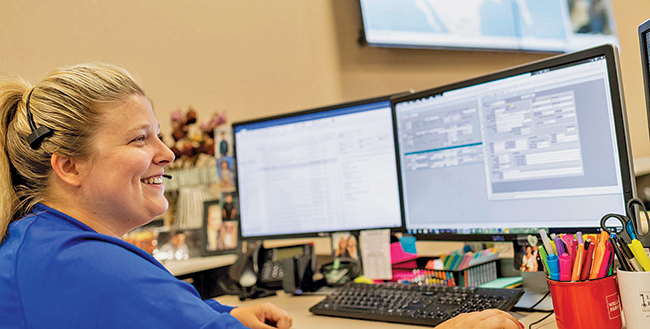
Although some fleets have been shifting toward digital documents, many shippers still rely on paper. (Trimble)
Although software to create electronic bills of lading is readily available, many supply chain participants continue to use traditional paper documents, said Jay Delaney, senior director of product management at Trimble Transportation.
“Eventually, we’ll see a slow change to electronic receipts, but for now, 95% of the consignees want to see that piece of paper,” he said. “In that regard, any electronic bill that can be created can be put on paper so we have software that does that, either ourselves or through a third party.”
Resistance Fades Amid Pandemic
Historically, there have been several obstacles to industrywide implementation of eBOL solutions.
These challenges have included a learning curve, driver acceptance and persuading users to adopt yet another app.
For shippers, it was hard to integrate so many software systems to allow for eBOL.
But, as Zonar’s Fakkema said, the pandemic has forced the hand of many companies to go electronic.
Vector’s Belcher agreed, stating, “I strongly believe that COVID-19 is an accelerator of existing trends.”
Earlier this spring, J.B. Hunt Transport Services announced it would transition to eBOLs as part of the new normal.
“The new electronic BOL feature is easy to use and provides safer interactions between truck drivers and on-site personnel at customer locations by reducing or eliminating the exchange of paper documents,” the company stated in a May 1 announcement. “Using Carrier 360 or the J.B. Hunt Drive app, drivers are able to securely send the eBOL to customers for electronic confirmation and signature. A signed proof of delivery is then emailed to the customer.”
J.B. Hunt, based in Lowell, Ark., ranks No. 4 on the for-hire TT100.
Driver acceptance of electronic documents also may be growing.
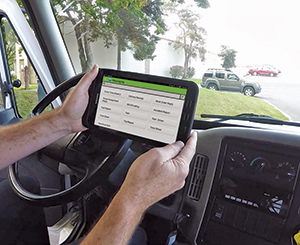
A driver utilizes Zonar’s electronic bill of lading application on a mobile device. (Zonar)
Solimani reported that drivers at Stevens Transport were excited to use and test out the Vector technology, and they appreciated the efforts to keep them safe and limit their exposure at facilities when they have to exit their trucks.
“Prior to this, they’d have to get out of the truck three, four times; now they only have to get out of the truck once. It saves them time and hassle,” Solimani said.
Plus, from the company’s perspective, it streamlines the entire process.
A Post-COVID World
Even after the pandemic is fully under control or well behind us, there’s a good chance that the use of electronic bills of lading will continue to become more commonplace.
“I think we were moving in this direction even before the pandemic, and I think the pandemic really put a highlight on it. We’ll always have it because people will see how efficient it is and how it will help their operations throughout,” Zonar’s Fakkema said.
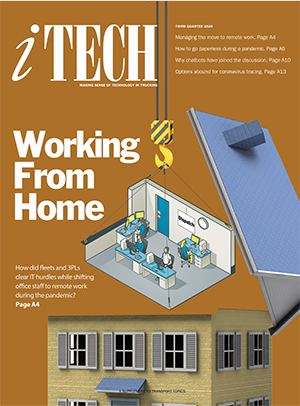
Read More iTECH Stories
►Clevenger: Trade Shows Go Virtual
►Dysart: Using Technology to Keep Employees Safe
►IT Investments Aid Work From Home Shift
►Adjusting to Electronic Bills of Lading
►Chatbots Reshape B2C Relationship
Solimani also made the case for continued adoption of electronic documents.
“Definitely, this should be part of the future of the entire supply chain process. It is surprising it hasn’t been happening before COVID,” he said. “This is a small piece of the pie to get us toward the future of getting everything electronic and to see where your freight is 24/7.”
KeepTruckin’s Gupta said: “The uptick has been there since the mandate, and with COVID, it is more important than ever. But the benefit of the technology for the driver or back-office staff has been so remarkable, it will only continue the trend. More fleets and drivers will realize that embracing technology will be beneficial in the long term. In a post-pandemic world, the trend will only accelerate.”
Still, Trimble’s Delaney said he thinks that going fully paperless will be a challenge because many shippers prefer using paper.
“The need for document management services will always be there. I don’t know if we’ll ever, as an industry, get away from paper completely,” Delaney said. “I think we’re starting to see a slight shift in acceptance of eBOL, but it will take a while. I’m not sure it’s a big enough shift to transform the industry.”
Explaining further, he said shippers and 3PLs in particular will need to see the benefit of switching to electronic documents.
“Currently, many shippers and 3PLs see value in paper. So long as they continue to see the value of a paper process with their payables, they will not be interested in making the move. So that leaves the carriers to drive the change,” he said. “In the [less-than-truckload] market, there isn’t a carrier large enough to drive a change with the shippers. Contrast this with the parcel industry, where a handful of predominant carriers exist. In this market, moving to eBOLs is much more likely as one carrier can make the change with much less risk of revenue loss.”
Want more news? Listen to today's daily briefing:
Subscribe: Apple Podcasts | Spotify | Amazon Alexa | Google Assistant | More

